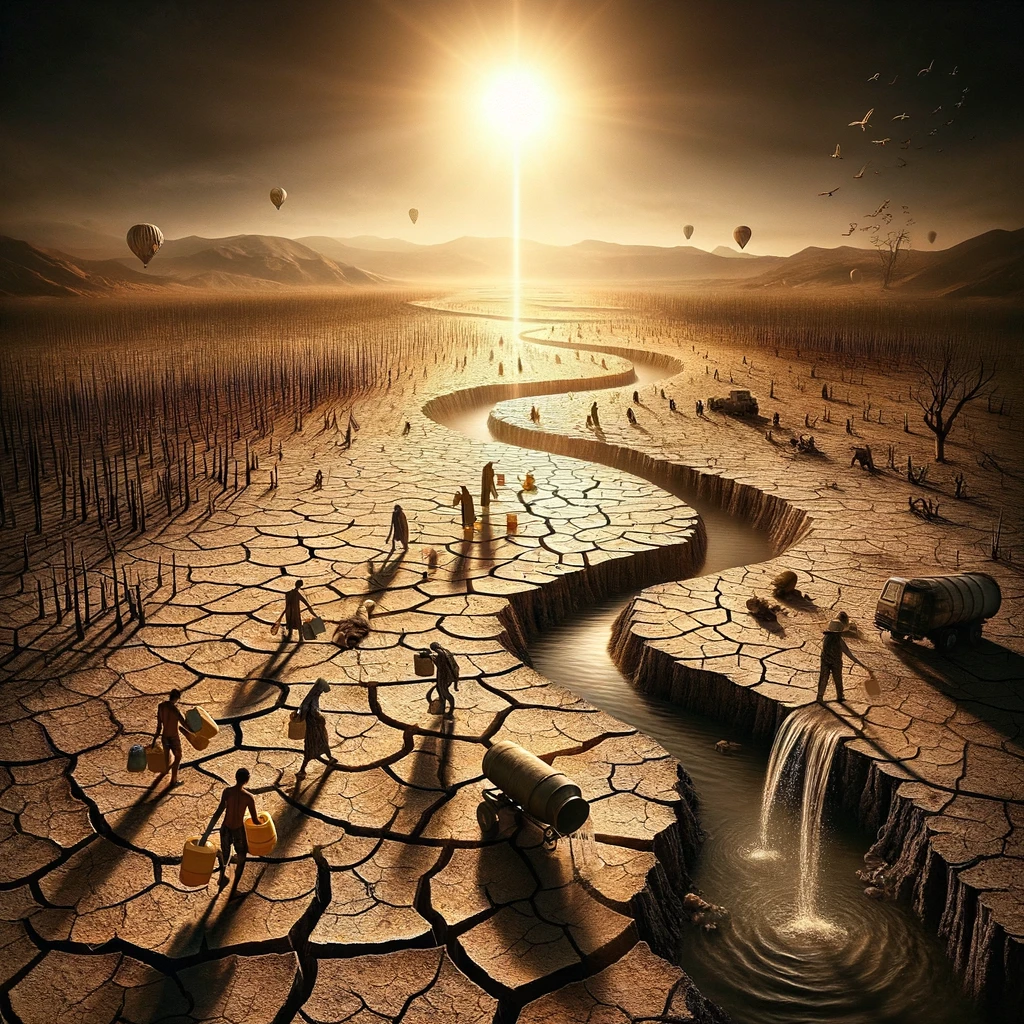AI Inspired & Created Art
Through the lens of AI-generated imagery and creative narratives, this page offers a compelling blend of art and information. While we strive to inspire awareness and reflection on environmental issues, it’s important to note that the content herein is a fusion of artistic expression and generalized information. The images and writings are crafted for engagement and thought provocation, rather than scientific accuracy.
Penguins on Thin Ice

Penguins on Thin Ice” captures the urgent message of environmental conservation through its vivid portrayal of a penguin family’s struggle. Penguins, iconic birds primarily found in the Southern Hemisphere, rely on specific habitats for breeding, feeding, and survival. The majority inhabit the icy waters and islands of Antarctica, but some species are also found on the coasts of South America, Africa, and New Zealand.
Penguins depend on sea ice as it plays a crucial role in their life cycle by influencing the availability of krill, small fish, and squid – their main food sources. Krill, a key component in the Antarctic food web, depends on ice algae that grow on the underside of sea ice. As climate change accelerates ice melt, the reduction in sea ice leads to a decrease in krill populations, thus threatening the penguin’s food supply.
The illustration of penguins on a melting ice floe, under a sky that reflects the warming world, serves as a powerful visual metaphor for the challenges faced by these creatures due to global warming. It is a call to action, urging us to acknowledge and mitigate the impacts of climate change to preserve the natural habitats of penguins and countless other species affected by our changing planet.
Divided Landscapes:
The Realities of Climate Change & Poverty

In a world starkly divided by the consequences of climate change, the illustration lays bare the contrasting realities of wealth and poverty. On one side, a landscape parched by relentless droughts showcases the grim struggle for survival. Cracked earth stretches as far as the eye can see, a testament to the scarcity of water that once gave life to this land. Communities here face the unyielding challenge of sustaining crops in soil that offers little more than dust. The image captures the essence of despair as these communities grapple with the unforgiving conditions wrought by environmental degradation, their lives a daily testament to the acute vulnerabilities imposed by poverty.
Contrastingly, the other side of the illustration reveals a scene of abundance and resilience—an oasis in the midst of a desert. Here, well-irrigated fields flourish, and clean water flows, symbolizing the stark disparities in access to resources and the ability to adapt to climate change. This side of the divide enjoys the privileges of technological advances and infrastructure that shield them from the harsh realities faced by their less fortunate neighbors.
This powerful depiction serves as a poignant reminder of the urgent need for inclusive climate action. It emphasizes that the battle against climate change is not only environmental but deeply intertwined with social equity, calling for solutions that bridge the gap between prosperity and poverty, ensuring a sustainable future for all.
Thirsty Earth: Climate Change & Water Scarcity

This illustration powerfully captures the devastating impact of climate change on water scarcity, presenting a landscape deeply scarred by environmental degradation. A vast, cracked earth stretches under the relentless gaze of a scorching sun, epitomizing the severity of drought conditions that have become increasingly common in many parts of the world. The riverbed, once a lifeline for the surrounding ecosystem, now lies parched and empty, a stark testament to the dire consequences of prolonged water shortages.
In the foreground, individuals traverse this desolate landscape, their empty water containers a poignant symbol of their desperate search for water. Their journey is a visual narrative of human vulnerability in the face of environmental crisis, highlighting the pressing need for sustainable water management practices.
Beyond the immediate struggle for survival, the background reveals a broader ecological crisis. Wilted crops and dying trees dot the horizon, signaling the collapse of local agriculture and the loss of biodiversity. This grim scenario underscores the interconnectedness of climate change, water scarcity, and food security, emphasizing the urgent need for concerted global efforts to address these challenges and mitigate their impacts on vulnerable communities and ecosystems.
The Daily Journey for Water in Rural India

“The Daily Journey for Water in Rural India” captures the poignant reality of a rural Indian woman’s daily struggle against poverty and water scarcity. Dressed in simple, well-worn traditional clothing, she embodies the perseverance of those who face the arduous task of securing one of life’s most essential resources: clean water. The large, old water container balanced on her head is not just a vessel; it’s a symbol of the burden borne by many women in developing regions, where access to water is a daily challenge.
Set against the backdrop of a dry, arid landscape with sparse vegetation, the image highlights the harsh environmental conditions exacerbated by climate change and unsustainable water management. These conditions disproportionately affect impoverished communities, placing an additional strain on their already limited resources. The woman’s expression, a mix of determination and fatigue, tells a story of resilience and strength. It reflects the resolve of those who, despite facing economic hardships and physical exhaustion, continue their daily journey to provide for their families.
This powerful depiction serves as a stark reminder of the critical issues of water scarcity and poverty, emphasizing the urgent need for comprehensive solutions that address both access to clean water and the underlying social and economic inequalities.